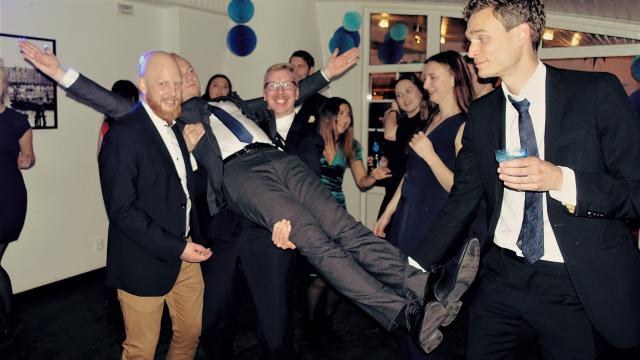Throwing the perfect party requires more than good booze, pleasant music and tasty snacks. It requires the right number of people to develop the atmosphere you’re after. This formulaic approach to party invites will help you host the biggest bash or the most charming of dinner parties.
Photo by Magnus Lönnegren Wikensten.
[referenced url=”https://www.lifehacker.com.au/2017/11/the-secret-to-getting-people-to-actually-come-to-your-party/” thumb=”https://www.lifehacker.com.au/wp-content/uploads/sites/4/2017/11/Party-Alone-410×231.jpg” title=”The Secret To Getting People To Actually Come To Your Party” excerpt=”You talked about your plans with your friends face to face, you made a Facebook event page and invited them – but people still seem to flake out on you. What gives? Well, you’re still not making it easy enough for them.”]
Measure Your Hosting Space
First, calculate your hosting space by adding up all the square footage (area, or length x width) of the rooms you’ll be having guests in most of the time. Places such as the living room, dining room, kitchen and patio. If you can, though, subtract the square footage of large pieces of furniture and other obstacles.
This will be your total usable square footage.
Decide On a Party Type
Different styles of party require different densities of guests. For example, a casual dinner party shouldn’t be as crowded as an all-night dance party. To determine your density, we’ll be using Maxwell Ryan’s calculations at Apartment Therapy (sticking with the “lively” category):
- Gathering: If it’s something more intimate, such as a dinner party, you’ll need 15 square feet per guest to create the right atmosphere.
- Party: If you’re having people over for cocktails, a small birthday, or general merriment, you’ll need 10 square feet per guest.
- Rager: If you want dance and drink the night away with a crazy party for the ages, you’ll only need 6 square feet per guest. Any less, and people will feel too self-conscious to loosen up and dance.
Now that you know both your hosting space and your party type, you can start doing some maths.
Calculate Your Maximum Attendance
Your maximum attendance represents the total number of people you can hold in your hosting space based on your party type. Here’s how you calculate it:
(total usable square footage) / (15, 10 or 6 square feet per person, depending on the party type) = maximum attendance (MA)
Since density is important for setting the right mood, you want to get as close to your maximum attendance as possible.
Find Your Real Attendance Number
Your maximum attendance is not how many people you should invite, however. After all, you have to consider how many people will actually accept your invitation. The general consensus is that two-thirds of the people you invite will actually come, so:
MA x (2/3 acceptance rate or .67) = real attendance (RA)
Now you have an educated guess as to how many people will show.
Guesstimate Your Buffer Invites
Still, you want to adjust for that ratio so you still get as close to your MA as possible. To do that, you need to add a buffer:
MA – RA = buffer invites (BI)
Once you know your BI, you can find out how many invites you really need to send out for your party:
MA + BI = required invites (RI)
That will ensure your party atmosphere matches what you had planned.
(Optional) Calculate an Unexpected Guest Buffer
OK, but what if you expect some of your guests to bring extra people along? If you’re not going to have a “no +1s” rule, you’ll need to give yourself some wiggle room. Patti at Smooth Weddings suggests you should expect 115 per cent of the guests you invite in that case. So:
( 1.15 x RI ) – RI = unexpected guest buffer (UGB)
That means, your total number of invites should actually shrink a little to account for tag alongs:
RI – UGB = your total number of invites (TI)
Now you’ve calculated for almost all possibilities.
A Party Architecture Example
OK, so what do these formulas look like in action? Here’s an example (numbers get rounded):
Say you want to throw a rager in 200 square feet of usable space.
That would look like ( 200 / 6 ) = 33.3333, but we’ll round down to a 33 MA
Now, we find the buffer invites and required invites…
33 – (33 x .67) = 33 – 22 = 11 BI
33 + 11 = 44 RI
And give ourselves an unexpected guest buffer…
(44 x 1.15) – 44 = 50 -44 = 6 UGB
so…
44 – 6 = 38 total invites (TI) to perfectly fill out your 200 square foot rager
Those 38 invites would get you pretty close to that 33 person maximum. If you’d rather have the whole formula upfront, you can use this:
If y = square feet per person, and z = total usable square footage, then total number of invites (TI) = ((z / y) + ((z/ y) – ((z / y) x .67)) – (( 1.15 x ((z / y) + ((z / y) – ((z / y) x .67))) – ((z / y) + ((z / y) – ((z / y) x .67))
Or calculate the MA upfront and use this (it’s a bit easier):
( MA + ( MA – ( MA x .67 ) ) – ( ( 1.15 x ( MA + ( MA – ( MA x .67 ) ) ) – ( MA + ( MA – ( MA x .67 ) ) )
Now, when people ask you how you throw the perfect parties, you can tell them you use the power of maths.

Comments